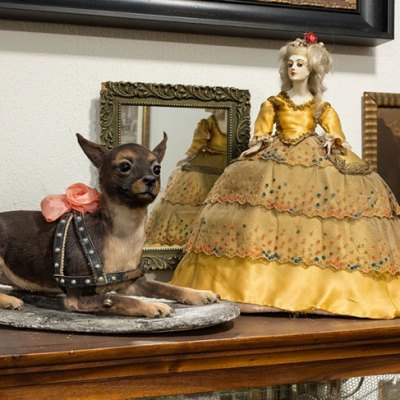The Italian critic and curator Germano Celant has died at the age of 79. The man who in recent years held the roles of Fondazione Prada director, Guggenheim curator, and ArtForum contributing editor fell ill with Covid-19 after a trip to New York in early March, and died from virus-related complications in Milan on 29 April 2020.
Celant was best known as the champion of – and coiner of the term – Arte Povera, describing the work of artists in Turin, Milan, Rome and Genoa who embraced everyday materials and unconventional processes. One of his last, and most admired, shows was the Jannis Kounellis retrospective at the Fondazione Prada in Venice in 2019. Over six decades, Celant successfully turned a loose artistic grouping into modern Italian art’s most valuable export. In so doing, he created a brand out of Arte Povera, and out of himself.
Installation view of ‘Jannis Kounellis’, curated by Germano Celant, Fondazione Prada, Venice, 2019. Photo: Agostino Osio/Alto Piano; courtesy Fondazione Prada

Born in Genoa in 1940, Celant made his name in that city at just 27 with the exhibition ‘Arte Povera – Im Spazio’ at Galleria La Bertesca, which included work by Kounellis, Luciano Fabro, Alighiero Boetti and Pino Pascali. Two months later, his essay-cum-manifesto ‘Arte Povera: Notes for a Guerrilla War’ (1967), published in Flash Art, introduced ‘a poor art concerned with contingency, events, ahistoricism, the present’. This parallel activity of exhibition-making and writing continued throughout his career.
Following the seminal ‘Arte Povera + Azioni Povere’ in Amalfi, organised in 1968 with Marcello Rumma and including interventions by Michelangelo Pistoletto and Mario and Marisa Merz, Celant went international. His alliance of Arte Povera with conceptual and land art tendencies in the US was highly influential and hit the zeitgeist captured in Harold Szeemann’s landmark show of 1969, ‘When Attitudes Become Form’, which brought together 69 artists from around the globe including a number of those promoted by Celant.
Expanding his purview to the earlier Italian artists Lucio Fontana and Piero Manzoni, writing the latter’s catalogue raisonné in 1974, Celant created a virtual monopoly on post-war Italian art. Only after three decades was his dominance critically appraised by a new generation of scholars taking Celant’s approach as subject rather than model. Renewed attention on the artists he excluded and other strands of post-war Italian art and criticism has shown how effectively Celant brought the entrepreneurial spirit of F.T. Marinetti’s futurism to post-war art.
The success of Arte Povera shows in the US, such as ‘The Knot’ at P.S.1 in New York in 1985, led to Celant’s appointment as a senior curator (until 2008) at the Solomon R. Guggenheim Museum. There he staged major exhibitions of international contemporary artists, while continuing to promote his Italian coterie. Highly impactful in the field of modern Italian art history was the interdisciplinary exhibition ‘The Italian Metamorphosis, 1943–1968’, held at the Guggenheim in 1994–95, which brought together the peninsula’s art, architecture, cinema, product design and fashion.
Celant, who became artistic director of the Fondazione Prada in Italy in 1995 – and was instantly recognisable in person for his own minimalist monochrome style – foresaw the potential mutual benefits of a marriage of art and fashion. The following year he dedicated the Biennale di Firenze, co-curated with Ingrid Sischy, to pairing up artists and fashion designers. He gave Giorgio Armani a retrospective at the Guggenheim in 2000, well before museum fashion shows were à la mode. Such collaborations, and Celant’s interest in the museum visitor as consumer of culture, led to accusations of commercialism. As curator of the 47th Venice Biennale in 1997, an exhibition which he pulled together in a mere five months, Celant drew criticism for the prominence of blue-chip artists in his selection and display.
Installation view of ‘When Attitudes Become Form: Bern 1969/Venice 2013’, curated by Germano Celant, Fondazione Prada, Venice, 2013. Works by (from left to right): Bill Bollinger, Gary B. Kuehn, Keith Sonnier, Walter De Maria, Bill Bollinger. Photo: Attilio Maranzano; courtesy Fondazione Prada

In the last decade, the scale of Celant’s output grew even more ambitious. ‘Arte Povera 2011’ was staged across eight Italian museums and cultural institutions. His contribution to the Milan Expo in 2015, ‘Arts & Food’ at the Triennale di Milano, occupied a space the size of a football pitch. His restagings of ‘When Attitudes Become Form’ at the Fondazione Prada in Venice in 2013 and Fascist-era exhibitions in ‘Post Zang Tumb Tuuum’ at the foundation’s Milan space in 2018 likewise suggested a shift from the role of kingmaker to that of disinterested historian. These projects, like many of their predecessors, relied on the tireless research of generations of younger art historians influenced by this giant of Italian art.
It was already clear that the Italian art world would be profoundly changed by the pandemic. The loss of Celant will make that transformation all the more powerful.


